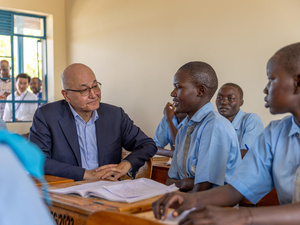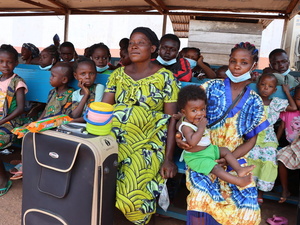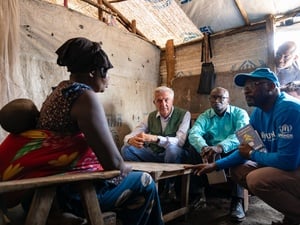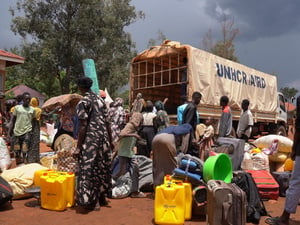Thousands head towards Goma in eastern DRC to escape conflict
Thousands head towards Goma in eastern DRC to escape conflict
Pressure is mounting on Goma, eastern Democratic Republic of the Congo, with more than 19,000 people seeking shelter in nearby areas since Sunday to escape fighting between government forces and renegade troops. As of last night, 4,100 people had carried on past Goma, capital of North Kivu province, and sought shelter in nearby Rwanda, where we are providing basic aid.
UNHCR field staff say people are still coming to Goma and its environs from their homes in the Masisi and Walikale areas, but the flow has eased a bit. UNHCR staff have registered 10,300 people at a spontaneous site 25 kilometres from Goma and 9,000 in Mugunga III, one of 31 UNHCR-run settlements for internally displaced people in North Kivu.
Hundreds are sleeping in a school and church at the spontaneous site, while about 1,000 people are heading to South Kivu. We are working with our partners to provide assistance, including shelter and other non-food items. Our protection staff are in the field monitoring needs and identifying the most vulnerable internally displaced people (IDPs).
The latest figures add to the already massive displacement numbers recorded in North Kivu and neighbouring South Kivu so far this year. Conflict in the first quarter of the year is estimated to have displaced around 300,000 people, according to figures compiled by the UN Office for the Coordination of Humanitarian Affairs (OCHA) with input provided by UNHCR and other organizations. With the latest figures, more than 2 million people are now uprooted countrywide, including 1.4 million people in the two Kivus.
Most of the displaced are in South Kivu where, in the first three months of this year, 220,000 people have fled continuing clashes between the rebel Democratic Forces for the Liberation of Rwanda (FDLR) and the Mai Mai militia. Displacement has also been seen from joint military action by UN peacekeepers and the Congolese armed forces, although this operation has now been suspended.
In North Kivu, fighting between government forces and soldiers loyal to former rebel commander Bosco Ntaganda intensified in April. An estimated 58,000 were newly displaced in the province between January and March. We are particularly concerned for some 38,000 displaced people in the areas of Masisi and Walikale. UNHCR is unable to access these people because of the insecurity. Many are in IDP settlements located in areas now under the influence of rebel or militia groups. They include the Mpati site, where there were more than 9,000 people, as well as Nyange (1,305 people) and Kivuye (2,717 people).
UNHCR is appealing to all sides to urgently allow humanitarian access to these vulnerable groups and to respect their rights, including the rights to safety, medical help and freedom of movement. We also stress how important it is to maintain the civilian character of the camps and we urge the provincial authorities to increase security in and around the camps where possible.
Meanwhile, our office in Rwanda reports an average of 1,000 people a day have been crossing into Rwanda at the Goma-Gisenyi border point since the weekend. Most are women, children and the elderly coming from Masisi and Walikale, via Goma. The new arrivals are being transferred to a transit centre inside Rwanda and receiving humanitarian assistance.
For more information:
- Celine Schmitt, +243 81 700 9484
- Simplice Kpandji (Goma), +243 81 833 1322
- Leo Dobbs, +41 79 883 6347
- Fatoumata Lejeune-Kaba, +41 79 249 3483
- Vivian Tan (Nairobi) +254 735 337 608
Email addresses and phone numbers for all UNHCR press officers can be found at http://www.unhcr.org/pages/49e6e9c42e.html








